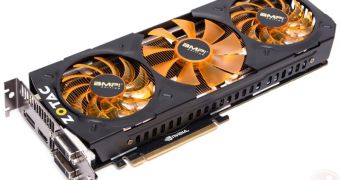NVIDIA's GeForce GTX 780 Ti continues to be the rave of the high-end desktop PC video industry, which is why we're not at all surprised to hear of the latest one from Zotac, or that it has been tested and overclocked beyond regular parameters.
Given the recent exposure of the EVGA GeForce GTX 780 Ti Kingpin Edition and the ASUS GeForce GTX 780 Ti ROG Poseidon, we were half-expecting it really, to see another one out and about.
Clearly, Zotac didn't pull any punches. Not only did it refashion the PCB, added better components and overclocked the board to kingdom come, but it also changed the cooler.
Of course, you can't really have one without the other. Well, you could, but it would pretty much waste the extra performance potential.
After all, while stronger components and coolers can, individually, provide a greater performance and overclocking headroom, they can achieve greater heights together.
And the price of the GeForce GTX 780 Ti AMP!, as the graphics card is called, isn't bound to be too far from the normal $700 / €700, and even if it were, it wouldn't matter because people who buy top-grade hardware are always the ones with both the need and the money for it. Well, most of the time anyway.
But we digress. Basically, Zotac has created the GTX 780 Ti AMP! (ZT-70503-10P), featuring a GK110 GPU working at 1006 MHz, or 1072 MHz GPU boost. The memory works at 1800 MHz (7200 MHz effective).
For the sake of comparison, the normal board functions at 875 MHz and 928 MHz, respectively, and the memory at 1750 MHz / 7200 MHz. Clearly, quite a way behind. And even so, it's the best there is, which can give you some perspective as to where the Zotac AMP! will rank.
The cooler is called Triple Silencer and has two 75 mm fans and one 8.5 mm fan in the middle. Five heatpipes are used, as well as a large heatsink. The only drawback is that the 6-pin and 8-pin connectors haven't been replaced by dual-8-pin power inputs, which kind of limits the overclocking. Nevertheless, the board has already been pushed to 1222 MHz without side effects.

 14 DAY TRIAL //
14 DAY TRIAL //